Notes on the Notes – February 11, 2018

This week’s theme:
To be Transfigured
This week’s scripture readings:
2 Corinthians 4:3-6 Mark 9:2-9
This week’s music:
Throughout the season of Epiphany, we have been reflecting on what it means to hear God’s call. This week’s reading from Corinthians refers to the preaching of the Gospel that dispels darkness. The light of knowledge that shines in our hearts must be reflected and shared with others. The Gospel reading from Mark is the story of the Transfiguration. What does it mean to be transfigured by having God in your life? How does hearing God’s call change you? This week’s music makes reference both to the Transfiguration story and symbol of light.
“Open My Eyes” (VU #371)
“Open my eyes, that I may see glimpses of truth thou hast for me;
place in my hand the wonderful key that shall unclasp and set me free.
Silently now I wait for thee, ready, my God, thy will to see.
Open my eyes, illumine me, Spirit Divine!
Open my ears, that I may hear voices of truth thou sendest clear;
and while the wave-notes fall on my ear, everything false will disappear.
Silently now I wait for thee, ready, my God, thy will to see.
Open my ears, illumine me, Spirit Divine!
Open my mouth, and let me bear gladly the warm truth everywhere;
open my heart and let me prepare love with thy children thus to share.
Silently now I wait for thee, ready, my God, thy will to see.
Open my heart, illumine me, Spirit divine!”
Clara H. Scott (1841-1897) provides us with a hymn of consecration that has been sung for over 100 years. The text of “Open My Eyes” was written in 1895 shortly before Scott’s death. Each stanza reveals an increasing receptiveness to the “Spirit divine.” Open eyes lead to “glimpses of truth.” Open ears lead to “voices of truth.” An open mouth leads to sharing the “warm truth everywhere.” An open heart leads to sharing “love to thy children.”
The image of open eyes is common in the Bible. In some cases, this is a sign of Christ’s healing power, as when Jesus gave sight to the blind man. Closed eyes, on the other hand, could be a metaphor for avoiding the truth. The image of open ears is also significant in the biblical witness. Matthew often reprises the theme “Who hath ears to hear, let him hear.” Closed ears become a metaphor for a lack of understanding. While the eyes and the ears are receptive organs, the mouth has the capacity to project. The mouth may project “cursing and deceit and fraud” (Psalm 10:7), or it may be an organ that projects praise, as Psalm 51:15 exhorts us: “O Lord, open thou my lips; and my mouth shall show forth thy praise.”
Sing along with the choir at First United Methodist Church in Valdosta, Georgia at: https://youtu.be/71jExPuxRBY
“O Splendour of God’s Glory Bright” (VU #413)
“O splendour of God’s glory bright, from light eternal bringing light;
O light of life, light’s living spring, true day, all days illumining;
Come, Holy Sun of heavenly love, pour down your radiance from above,
And to our inward hearts convey the Holy Spirit’s cloudless ray.
O joyful be the passing day with thoughts as clear as morning’s ray,
With faith like noon-tide shining bright, our souls unshadowed by the night.
O Christ, with each returning morn your image to our hearts is born;
O may we ever see anew our Saviour and our God in you!”
The text of this hymn comes from “Splendor Paternae Gloriae,” a hymn by Ambrose, Bishop of Milan (ca 174), who encouraged the development of hymn singing in the Western Church, having heard hymns sung in Eastern Orthodox churches during his travels in Greece. The translation is based on the work of John Chandler in Hymns of the Primitive Church (1837). The words reference both God and Jesus as being sources of divine light. Through the hymn, we are asking to be bathed in the divine light as we live our every day life. The tune, PUER NOBIS NASCITUR, is from a 15th-century Tier manuscript. It may be familiar as the tune for the hymn “A Little Child the Saviour Came” (VU #445)
Hear the tune on the organ at: https://www.youtube.com/watch?v=Wu-1qlh7YFU
“How Good, Lord, to be Here” (VU #103)
“How good, Lord, to be here! Your glory fills the night;
Your face and garments, like the sun, shine with unborrowed light.
How good, Lord to be here, your beauty to behold,
Where Moses and Elijah stand, your messengers of old.
Fulfiller of the past and hope of things to be,
We hail your body glorified, and our redemption see!
Before we taste of death, we see your kingdom come:
We long to hold the vision bright and make this hill our home!
How good, Lord, to be here! Yet we may not remain;
But, since you bid us leave the mount, come with us to the plain.”
This hymn was written by Joseph Armitage Robinson (1888) for the feast of the Transfiguration, which, in the United Church, is celebrated on the last Sunday before the beginning of Lent. It is written as if we, too, are on the mountaintop with the disciples. It encourages us to both experience the wonder of the Transfiguration of Jesus and to follow Jesus back down the mountain toward the cross. The tune, CARLISLE, is by Charles Lockhard (1792). Learn more about the Transfiguration at: http://en.wikipedia.org/wiki/Transfiguration_of_Jesus
“Shine On, Great Savior”
“He called us up to the mountain.
We followed the Master’s call.
And we were changed forever by the glorious things we saw.
There came a light on the mountain,
His face shone like the sun,
And His robe was white with the glorious light,
The light of the Holy One.
Now shine on, great Saviour.
Come and make this a holy place.
Shine on, great Saviour,
And show us your power and grace.
There came Elijah, great prophet,
There was Moses, great man of law.
And there stood the great Messiah,
Who shone the brightest of all.
A bright cloud overwhelmed them.
From the cloud, a voice was heard,
“This is My Son, My Chosen One,
Now listen to His every word.”
I remember that day on the mountain as I live in this valley below.
And through all my days of darkness,
There’s one thing that I know.
There was glory on the mountain.
What wonder did I see!
And the glory on the mountain will forever be living in me.”
This Appalachian flavored song retelling the Transfiguration story is by composer Pepper Choplin and comes from the cantata “Come, Touch the Robe” which was published in 2009. The final verse of the song tells about the change in the singer after seeing the Transfiguration – “and the glory on the mountain will forever be living in me.”
“Love Divine, All Loves Excelling” (VU #333)
“Love divine, all loves excelling, joy of heaven to earth come down,
Fix in us thy humble dwelling, all thy faithful mercies crown.
Jesus, thou art all compassion, pure, unbounded love thou art;
Visit us with thy salvation, enter every trembling heart.
Come, almighty to deliver; let us all thy grace receive;
Suddenly return, and never, nevermore thy temples leave.
Thee we would be always blessing, service thee as thy hosts above,
Pray, and praise thee, without ceasing, glory in thy perfect love.
Finish, then, thy new creation; pure and spotless let us be;
Let us see thy great salvation perfectly restored in thee,
Changed from glory into glory, till in heaven we take our place,
Till we cast our crowns before thee, lost in wonder, love, and praise.”
This hymn was written by Charles Wesley in 1747. Charles Wesley was an English leader of the Methodist movement, one of the founding faiths of the United Church of Canada. Charles Wesley wrote over 6500 texts and was known as the “sweet singer of Methodism.” The text is derived from John Dryden’s “Fairest Isle, all isles excelling” in Henry Purcell’s opera King Arthur (1691). Note that in the third verse, we become the “new creation” as we are transformed from “glory into glory.”
Hear the Mormon Tabernacle Choir sing this hymn at: https://youtu.be/yRF4KKx7czU
BONUS VIDEO:
Categories: Notes on the Notes


You must be logged in to post a comment.